It might seem that hellebores are for expert gardeners and collectors only and a few of them are. The rest may look delicate, fussy, and difficult to grow but are quite amenable to cultivation in a fairly wide range of soils and situations. Hellebores, especially species but also many of the hundreds of cultivars, lend a connoisseur’s cachet to gardens in summer-dry parts of the world.

Helleborus orientalis, beautiful in its own right, is the main parent of many hybrids
If you are a newcomer to hellebores, there are several things it might be helpful to know. First, many of the hellebores you will find online and in nurseries or garden centers will be hybrids highly bred for ever more colorful and exotic-looking flowers and foliage. Species, subspecies, and selections of species are available, but you may have to hunt them down.
Hellebores in the wild are quite variable, even within species, but all have lobed or divided leaves and long-lasting, usually downward-facing flowers that consist of tiny floral parts surrounded by showy sepals that appear to be petals.
Twelve to twenty hellebore species and their subspecies have been classified into six sections or groups based on such traits as size, color, and form of flowers and leaves and on their ability to hybridize.
Species also are differentiated by whether the plants bear leaves and flowers on above-ground stems, as shrubs do, or whether basal leaves and leafless flowering stalks arise directly from the rhizome in the manner of bulbs and many succulents.
Stemmed plants are called caulescent; those without stems are acaulescent. Stemless plants can be propagated by division; shrubby stemmed plants are propagated by cuttings or by seed. Many hellebores of both kinds will self-sow where conditions are favorable. In commercial production many hybrids are propagated by tissue culture.

Helleborus argutifolius is a shrubby, stemmed plant with evergreen leaves
While hellebore classification continues to develop and likely will change, six sections described in 1989 are useful in thinking about hellebores, their care, and their placement in the landscape.
Four of the six sections contain only one species. Two of these species are difficult to grow and the first is nearly impossible to find. Rarely available, Helleborus vesicarius is a stemmed, summer-dormant, alpine species native to southern Turkey and northern Syria. H. thibetanus, until recently hard to find, is also summer-dormant but stemless. It is the only hellebore native to eastern Asia instead of central and eastern Europe and the Mediterranean.
The other two one-species sections include plants rather commonly available either as species or as cultivars. One is Helleborus foetidus, an evergreen, fall-blooming, two- to three-foot tall, stemmed plant with chartreuse sepals and dark green leaves divided into narrow segments. Native to mountains of western, central, and southern Europe, this species grows naturally in slightly moist, well-drained soil in part to full shade. In gardens it seems to do fine in dryish shade.
The other species in this section is Helleborus niger, the Christmas rose, a much smaller plant with pure white sepals that often fade to rose pink. H. niger is also evergreen but stemless, a foot tall or less, with large, outward- instead of downward-facing flowers on stalks that rise six inches above the rhizome. Leaves are leathery and dark bluish green with toothed margins.
Helleborus niger is native to both woodlands and open areas in the central and eastern Alps. The species, its subspecies, and its named selections do best in part shade and well-drained, alkaline soil with plenty of organic matter. Subspecies macranthus and several selections bear especially large flowers.
A fifth section contains two species, Helleborus argutifolius and H. lividus, both of which are stemmed and evergreen. Both are also native to the Mediterranean. The former is found in both sunny and partly shaded sites on the islands of Corsica and Sardinia. The latter is confined to moister, somewhat sheltered sites in the mountains of Majorca.
Helleborus argutifolius is a shrubby plant that can reach three or four feet tall and wide. Its large, bluish green leaves are prominently toothed and divided into three lobes. Sepals are greenish white or greenish yellow and flowers are held in clusters above the leaves.
Helleborus lividus is similar but much smaller, less than a foot to fifteen inches tall, with glossy, grayish green leaves and stems and sepals flushed with burgundy. Unlike H. argutifolius, this species is frost tender.
Closely related, H. lividus and H. argutifolius hybridize readily. H. x sternii is a popular hybrid that does well in full sun in mild-summer climates.
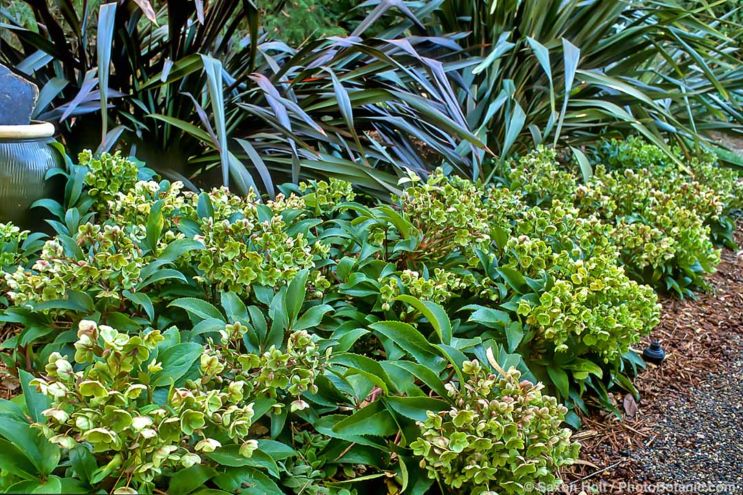
Helleborus x sternii is more cold hardy than H. lividus, one of its parents
The remaining hellebore species are lumped together into a single section. The number of species included here varies, largely because some plants are considered species by some botanists and subspecies by others.
Nine of the species in this large section hybridize freely in the wild and have been crossed and recrossed by breeders for hundreds of years. As a result, it is impossible to be sure which traits are in the genetic makeup of any modern hybrid involving these species. Hybrids are widely available, but some of the species are not.
Many hybrids have as one parent the species Helleborus orientalis, the Lenten rose. H. orientalis is an exceptionally hardy, deciduous plant native to the Caucasus and northeastern Turkey, where eastern Europe abuts western Asia. It is stemless, a foot to eighteen inches tall, with pinkish white and rose purple flowers from late winter through spring.
Hybrids involving this species are known as H. x hybridus but are often listed as if they were selections of H. orientalis. Most of the other species involved are native to woodlands and shrublands in the mountains of eastern Europe, especially the former Yugoslavia.
All of the Helleborus x hybridus crosses are stemless. Most are cold-hardy, twelve to twenty inches tall, with leaves and flowers in a wide range of sizes, shapes, and colors.
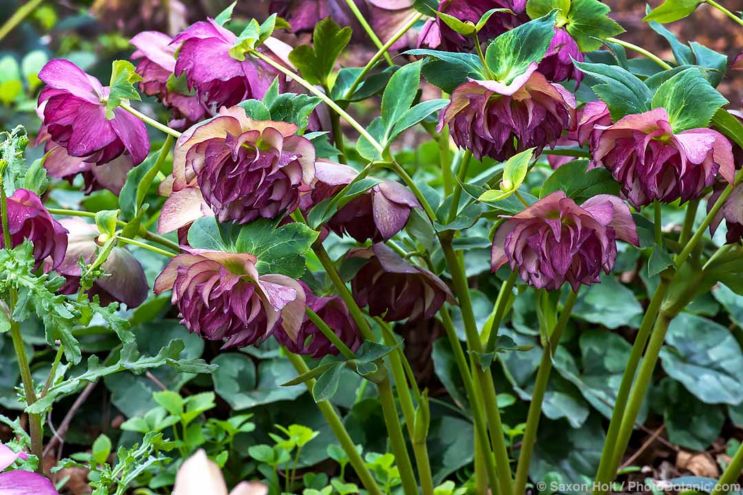
A double-flowered Helleborus x hybridus with purple sepals. Sepals of some hybrids are much darker purple. ‘Black Diamond’ sepals are almost black
Hybrids of many other species combinations are offered online and in nurseries and garden centers. Crosses involving H. niger and H. lividus are known as H. x ballardiae. These evergreen plants bear outward-facing, late-winter flowers with pale to rose pink sepals on purplish stems and leathery green leaves with prominent silvery veins. They seem to prefer part shade.
Species are often crossed with hybrids. Hybrids known as Helleborus x ericsmithii are somewhat tender crosses between H. niger and H. x sternii with dark green leaves and pink buds that open to greenish creamy white. These compact evergreen plants are happy in full to part sun.
Hybrids are also crossed with other hybrids. H. x glandorfensis indicates a cross between H. x ericsmithii and H. x hybridus with outward- or upward-facing, early-winter flowers and leathery, deeply lobed, dark green leaves. Sepals may be purplish red, grayed purplish, dark purple, or greenish white with purplish red margins. These plants are best in part sun to light shade.
Hybrids as a group require little or no supplemental water, especially if their sensitive roots are kept cool, which speaks loudly for mulch. Hellebore leaves, roots, and stems also are said to be toxic and to have an unpleasant burning taste, which may explain why they do not appeal to deer.
Hellebores do not respond well to division of the roots, but seed-grown plants may not come true to type. This is not necessarily a disadvantage. Homegrown hellebores are endlessly varied, some outstanding and some less so, which is a large part of the fascination with growing them.
Note: If you grow hellebores, let us know which ones and where you grow them. We all learn so much from the experience of others.


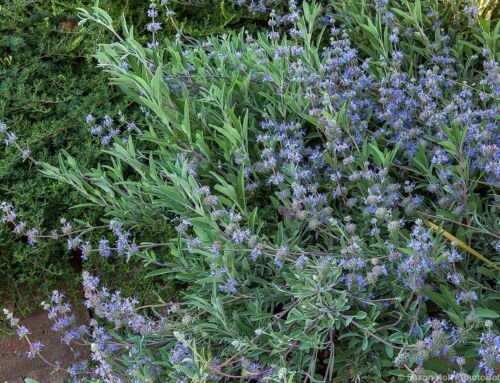
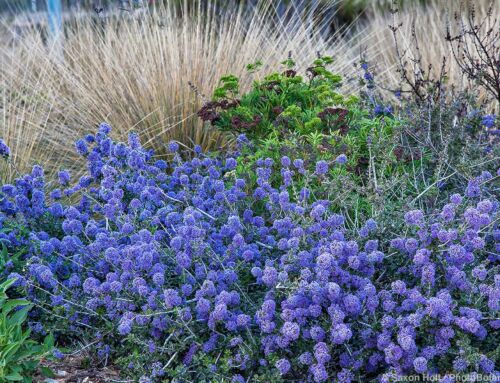
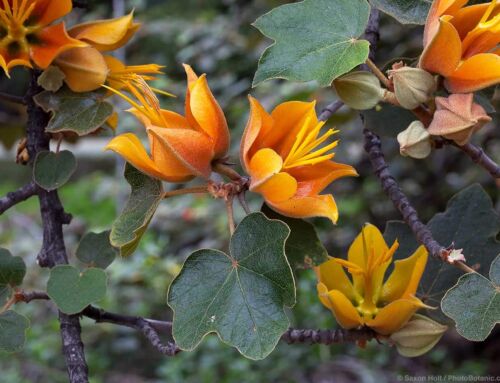
Leave A Comment